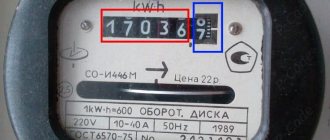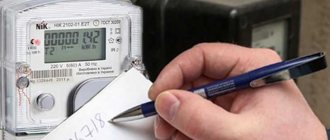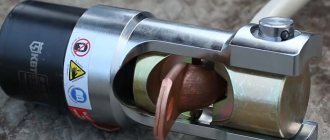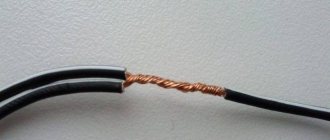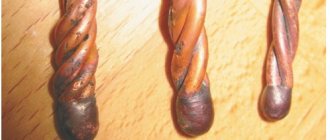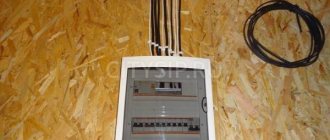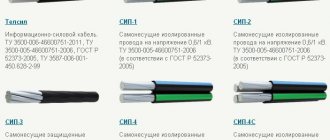Removing fluoroplastic insulation
This is a type of polymer coating that has good stable characteristics. The insulation coating is ideal, but quite expensive. It is customary to use it only for design calculations. This coating looks like a thin narrow tape tightly wrapped around a copper conductive wire. Only physical impact is suitable for removal. It is best to remove it using a sharp knife by scraping the surface layer to the required working length. Having exposed one edge, the wire is carefully bent to the side and the remaining insulating piece is cut off.
How to strip a wire while maintaining its properties
Let's start with simple methods.
Knife
A universal tool is used: a regular pen or office tool.
Improving the use of knives, many electricians make homemade devices for stripping insulation. For example, you can use a safety razor blade by simply screwing it to a clothespin.
Using holes of different diameters (on a clothespin), you get a universal tool for removing both the outer sheath and the coating directly on the conductors.
The simplest factory-made insulation stripping pliers work on this principle. The outer sheath is removed using calibrated holes, and conductors of small diameter are stripped using a blade with a molded hole.
Thermal method
If the question arises: how to quickly remove insulation from a wire, all means are good. Many craftsmen simply burn the ends of the conductors with a lighter or match. The method is not the best: Firstly, the cable may catch fire. Secondly, the remaining part of the shell loses its properties at a distance of 1–2 cm from the cleaned area. And finally, the conductor itself (copper or aluminum) is destroyed by such thermal effects.
If you need to quickly strip the wire, but there are no cutting tools, you can use a soldering iron. The tip of the conductor is burned with a hot tip, after which the insulation is easily removed.
There are thermal tools of industrial design.
Stripping the wires of insulation is carried out as follows: the heating elements are pressed to the cut point, the sheath is melted with a short pulse, the conductor remains untouched. Such devices can be stand-alone or part of soldering stations.
Advantage of wire thermocouples:
- Heating occurs pointwise; the copper or aluminum core does not change its properties.
- A thin melt line does not lead to waste of material.
- A sealed ring is formed around the shell, preventing the penetration of moisture.
The only limitation is the insulation material. Thermal stripping is used only in cables with polyvinyl chloride insulation. The fluoroplastic or rubber shell can only be removed mechanically.
Mechanical devices for stripping industrial wires
The most popular electrician tool is the “Insulation Stripping Complex”, known by the abbreviation KSI.
The operating principle is as follows:
During the initial compression of the pliers, the conductor is clamped between the grooved jaws (as in pliers), the other end is captured by the knife mechanism. The cutting attachment is spring-loaded and does not cut through the shell to the metal. This way the current-carrying core is guaranteed to be preserved. Next, the working levers are separated, and the notched sheath is removed from the wire.
The length of the area to be stripped is set using a limiter, against which the front wire rests when inserted into the tool.
There are certain restrictions: the tip cannot be too long. If you need to clean a long area, the process is repeated several times. In this case, the wire does not rest against the limiter, and the shifted section of the sheath is removed manually.
The complex copes well with both mono conductors and multi-core cores. There are restrictions on the diameter of the wire: a cable with a cross-section of more than 4.0 is almost impossible to process.
The next tool is simpler. End pliers for stripping insulation.
Designed for a diameter of up to 6.0 squares; it is difficult to expose a thicker wire manually. Between the cutting tips there is a screw stop, with which the diameter of the conductor is set. The distance between the grips is chosen to be slightly larger than the diameter of the current-carrying conductor. This is done to reduce the risk of damaging the metal. After squeezing the handles, the sheath is removed with a sharp movement along the wire. Working with such a device is not as convenient as with a CSI, but this is justified by its low cost.
Nippers, or the cutting sector of pliers, work in a similar way. Only stripping the wire with their help requires some skill.
The following device is designed to work with large diameter cables. This is a complex knife with a grip.
It can be used to strip wires of any length. First, a transverse incision is made, then a longitudinal one.
After which the sheath is easily removed without damaging the central conductor.
Stripping varnish-coated conductors
Such a conductor is used in transformer windings. Instead of a dielectric sheath, a thin varnish coating is applied to the copper core. The conductor is cleaned with a knife or sandpaper.
What can you use to strip wires?
Even if there is no stripper in the house, you can always find something to expose the metal end of the wire. This could really be any sharp object used to cut the plastic and something that can apply pressure to remove it. But in order for the work to be carried out more efficiently, it is worth having one of the following devices in the house.
Cable knife
A cable knife differs from a kitchen knife both in shape and in the quality of the steel. It's worth having in your closet just in case. Moreover, it costs very little, and can be useful for a wide range of tasks besides exposing the wire tip. The shape of the blade is similar to an eagle's beak, the tip runs along a concave line.
Pliers
Insulation stripping pliers – not to be confused with regular pliers. They are very different in appearance. This tool has protrusions with holes for wires of a certain diameter range. Another feature is the presence of a cutting edge. These pliers can be adjusted to the wire diameter of a given range. That is, this part is quite highly specialized and requires time spent on adjustments. There are much more convenient devices.
Pliers
The tool is similar to pliers, which are the prototype of pliers. But unlike their predecessor, they have two or three toothed recesses. When the wire is exposed, the smallest notch may be useful, and for stripping the cable, the larger one will be useful. This tool will be useful in the home where it may be needed infrequently, say, to fix an outlet. The car owner should think about something more convenient.
Automatic pliers
The mechanism of their work is very interesting to observe. At the ends of the clamps there are special jaws, which, when compressed, make an additional movement that pushes the insulation apart. This tool, unlike those listed above, is capable of carefully exposing the wire not at the end, but in the middle.
Stripper
For those who deal with wires more than once a year, it is highly recommended to purchase a stripper. The device is similar in principle to pliers, but at the end it has several holes for different wire diameters. Usually there are five.
Which stripping tool should I choose?
So what should you choose? Those who constantly work with wires need to have at least two tools - a stripper and automatic pliers. The stripper works only with the tip of a cable or wire, in this it is inferior in versatility to pliers. However, among all the tools considered, it performs its functions the fastest, is the simplest of all, and harms the wire less than other tools. Both pliers, knives, and pliers are designed in such a way that they can scratch the metal part, and this will negatively affect the conduction of current. The stripper does the job without any damage.
Automatic pliers are the only one of the listed tools that strips the wire in the middle. More precisely, a knife can perform the same function, but there is a risk of damaging the metal. Well, those who do not have any of the tools in the house will have to perform the operation with an ordinary well-sharpened kitchen knife. The process will require skill, and an amateur electrician risks cutting himself.
Self-cleaning of insulation
If you don't have time, you can hand over the copper cable uncleaned. In this case, the reward will be less.
The process of cleaning copper wire from the braid is unsafe and technologically complex. This requires appropriate equipment and special knowledge.
Minuses
self-cleaning:
- Large time and labor costs.
- Special knowledge and equipment required.
- The efforts expended do not always pay off, since cleaning large volumes is much easier, faster and more profitable to carry out at specialized enterprises.
Cable stripping equipment can be purchased, for example, from a Chinese supplier on aliexpress:
The main methods for cleaning copper cable are:
- Heat treatment
. This method is not used often, as it contradicts environmental standards. In addition, it has certain limitations: burning thin-stranded cable scrap is not recommended, since the metal can burn out along with the insulation. - Mechanical
. Removing insulation manually (stripping). A long and labor-intensive process. Its implementation is not always justified in terms of time and labor costs. To speed up the process, you can use a manual mechanical stripper. - Modern cleaning methods
using special technological equipment. For example, a powerful and productive automatic stripper. This method is the most effective and safe from an environmental point of view. And the removed insulation can also be sent for recycling.
To find out how to clean copper cable at home using available tools
, watch this video:
Cleaning with a stripper is represented by the following steps:
- inserting the end of the wire into the hole;
- by clamping the handles of the stripper and cutting the winding;
- by pulling out the conductive wire.
Thanks to the correct use of the stripper, you can quickly get rid of the winding, without the risk of damaging the used wire. The same applies to the side cutter, which cuts through the wire and facilitates free pulling of the wire. Using a special tool is effective in maintaining the quality of conductive wires. In our company, the price per kg of cable is high, especially without insulation. Although we are very familiar with effective ways to remove the braiding located on a copper wire without damaging the metal.
Stripping of current-carrying conductors is also carried out using special equipment equipped with a pair of moving units located in a solid housing. This option helps automate used cable cleaning.
The most common methods of removing insulation
When stripping current-carrying conductors, the presence of certain skills that are acquired only through practice plays an important role. This is especially true when handling thin conductors, where every wrong movement can lead to refraction.
Practical experience allows you to select the required force for pressing the tool, the angle of its application and the direction of movement in order to affect only the sheath of the wire, and not its core.
Among the popular methods of removing insulation, the following should be noted:
- using a knife;
- use of side cutters:
- exposure to high temperature;
- using a stripper.
Each of the methods listed may be applicable in different circumstances, and deserves a detailed description.
Removing braid with a knife
An example of the location of the knife relative to the wire when removing the top sheath.
The knife should be brought to the conductor at the most acute angle, practically sliding along the insulation, and act only in the direction “away from you,” which will make the process safe for both the product and the user.
Knife with a heel - an electrician's assistant when stripping insulation from a cable
Using side cutters to strip wire
Such a tool can only be used by experienced electricians, because any excess force will lead to either the wire being bitten off or damaged. There are two options for using side cutters:
- When working with a large cross-section conductor, the insulation is “bitten” from different sides, after which it is simply removed from the core
- The shell is clamped and cut through the cutting edges of the tool, after which it is pulled together with an axial movement to the side.
The second option requires special attention and accuracy.
Some brands make products with provided notches for safe removal of insulation from conductors of a certain cross-section, which makes it easier for household use.
Side cutters with notches for stripping wires with a cross section of 1.5 and 2.5 mm²
Removing insulation using high temperature
This method is suitable for cable and wire products that have an insulating coating of current-carrying conductors made of polyvinyl chloride. High temperatures can be created with a soldering iron or lighter. Under its influence, PVC loses its density and is easily pulled together with your fingers. Unfortunately, this method is only suitable for wires with a small cross-section.
Another disadvantage of this method is the fact that it is applicable only if it is possible to provide access to fresh air for ventilation, because the combustion products released can be unpleasant and even harmful.
Removing conductor insulation using an open flame from a lighter
Using a special tool - stripper
The following types of strippers are distinguished:
- simple manual - its operating principle is similar to the operation of side cutters that have notches for a certain cross-section of conductors;
- semi-automatic - has adjustment of the length of the exposed ends and removes insulation from the cores when the handles are closed;
- automatic - carries out several operations at once: trimming, stripping, twisting and crimping conductors.
The use of a stripper eliminates damage to live conductors and disruption of insulation in unintended places, which makes its use the most universal of the stripping methods under consideration.
The stripper removes the sheath in one motion without any harm to the core
How to quickly clean a cable for scrapping with your own hands
Used colored cable scrap is a popular and expensive recyclable material. You can extract it yourself from old power, fiber optic, telephone, installation, and other wiring. What tools and equipment will be needed to remove the winding? How to quickly clean a cable for scrapping, spending a minimum of time and effort?
Popular methods for stripping insulation
When handing over a cable, the metal core of the conductors is of value. Before going to the receiving point, you need to strip the cable from the insulating winding. There are several ways to do this yourself:
- manual stripping with a knife or hammer is a labor-intensive and time-consuming process, suitable if the batch of scrap is small;
- roasting and melting - a fast process, but harmful to the environment, not recommended for thin-stranded scrap, the metal burns out along with the winding;
- the use of special equipment is the fastest and safest method; tools are used during the work.
Cleaning with a knife or hammer
A construction or stationery knife or pullers with hooks, adjusting screws, etc. are suitable for stripping wires. When working, carefully cut the winding along the core, then take it to the side and cut it.
When working with a hammer, they hit the cable with force until the insulation separates from the metal.
Firing and reflow
You can burn raw materials over a fire, but the method is justified for large volumes of raw materials. Perform work outdoors, observing safety precautions.
Melting a cable with a soldering iron is one of the ways to remove insulation from thin and thick wires and cables. Before work, the wire is laid on a flat horizontal surface. Then heat up the soldering iron and apply it vertically to the winding. As the insulation melts, the cable is rotated around its axis. After firing, the plastic can be easily removed with pliers, tweezers, or pliers.
Important! Work in a well-ventilated area. When the insulation melts, toxins are released and there is a strong plastic smell.
Using a side cutter and stipper
How to quickly clean the cable for scrap delivery and mechanize the process? Special tools will help:
Side cutters are called wire cutters or tweezers for cutting wires. When using it, the free end of the wire is clamped between the blades, then carefully turned and pulled. The insulation is easily removed.
Note! The cutting edges are directed in the direction of movement of the tool so that the blades cut into the winding without much effort. If you handle the side cutter incorrectly, the cable will break off along with the insulation.
A stripper will help automate the cable cleaning process. There are different subtypes of the instrument. Models differ in the number of additional functions.
Stipper and working with it
The operating principle of all strippers is the same:
- the end of the cable is inserted into the hole of the tool;
- they clamp the handles of the stripper with their hands to cut through the windings;
- then the conductor is pulled outward, freeing it from insulation.
Important! The good thing about this tool is that it is simple and easy to use and is inexpensive. It rarely damages the cable, reduces winding removal time, and is suitable for working with single-core stranded conductors.
Special equipment
If there is a lot of scrap, special equipment for removing insulation will help simplify the preparation of raw materials. It can be rented directly from a centralized collection point.
Recycling collection points
Scrap acceptors purchase the following waste cable and wire products:
a) manufacturing defects, warehouse surplus;
b) used cable lines, production remains;
c) old uncleaned cable;
d) dismantled communications;
e) installation waste.
Acceptance is carried out according to several criteria, which determine the price per kg of scrap. The length of the conductor pieces, the percentage of scrap to insulation, and foreign impurities are taken into account.
It is recommended to hand over recyclable materials to collection points that have documents and permits to conduct this type of activity. Before weighing, the scrap is inspected and assessed by specialists.
By the way! To determine the weight of the metal without winding, the acceptance specialist cuts off a prototype conductor, strips it and weighs it.
Average price per kg of copper scrap for 2018-2019
| Scrap type | Description of scrap | Average price, rub./kg |
| Cable in winding | Covered with insulation | 250-290 |
| Copper cable | With a copper yield of 70% or more | 280-320 |
| "Oil" | With braid removed by hand. We accept raw materials without insulation, paint, varnish, paper, terminals, stains, or oxides. | 230-320 |
| "Mix" | Telephone cable, pigtail buses, wire, conductors. The presence of paint, varnish, oxides is allowed | 250-320 |
| "Shine" | Fully purified raw materials with a perfectly shiny surface | 330-350 |
| Copper after firing | Raw materials after heat treatment. | 310-330 |
The cost of aluminum scrap depends on the thickness of the core, Al content, and purity of the raw materials. Price range – from 20 to 70 rubles/kg.
Tips for Safely Stripping Insulation
Electrical work is not easy. Therefore, even if you have certain knowledge, you must not forget that the damaged core will eventually fail.
For safety reasons, when removing insulation that is slightly longer than required, the excess must be cut off. Exposed veins are too dangerous.
It is not advisable for a home handyman to purchase expensive tools in order to use them several times while removing insulation. In most cases, simple means at hand are quite suitable.
When working with a tool, you need to be extremely careful and attentive. The insulation should be pressed down slowly to avoid damage to the cores.
Microscopic damage to the conductors is invisible, so it is better to do everything slowly, but correctly, so as not to have big problems later.
To ensure reliable and safe contact, you need to use special terminal blocks.
It is not always advisable to remove the insulation if the cable consists of thin wires. It is possible, without removing the insulating layer, to separate the wires and use a special clamp with teeth to create contact
Contact when installing a piercing clamp will ensure the insulation is pierced. Sometimes that's enough.
We use side cutters
With this method, many often make the same mistake. The tool is taken without taking into account the direction of the cutting edges and begins to work. If the tool side is sharpened in the direction that coincides with the movement of the side cutters, then when removing the shell of the insulating material, a decent amount of force must be applied to close the edges of the tool. In this case, we risk cutting through the entire wire, and not just the insulating surface.
Note!
You should position the tool so that the sharpening side faces in the opposite direction from the movement of your tool.
It will be necessary to create a slight reinforcing effect, and the insulation will be removed with a characteristic tube. In this case, the wire is guaranteed not to receive even the most minimal damage.
Security measures
A conductor stripped of insulation is potentially a source of danger. After processing the wire, especially in places where it is pressed and scored, the insulation resistance should be measured. This is done when putting the electrical installation into operation, then the frequency of measuring the electrical wiring insulation is carried out according to the approved schedule.
If there is damage that reduces the protective ability of the shell, it is necessary to cut off the damaged area or put a dielectric casing on it.
That's all we wanted to say about it. To fully understand the issue, we recommend watching the video.
Removing fluoroplastic insulation
PTFE insulation
PTFE insulation means a polymer that is produced by a chemical method. It has a number of positive characteristics, for example, it does not get wet from water and is highly resistant to organic substances. Its technical characteristics allow it to withstand temperatures up to 300° C! It is an ideal option as insulation, but the main disadvantage is the high price. In this regard, I use it on special occasions. In everyday life it is used by many radio amateurs, since after soldering it has an aesthetic appearance, takes up little space and does not melt.
The material itself has the shape of a thin narrow ribbon. It, in turn, is tightly wound on a twisted stranded wire. It is only possible to clean such insulation with a knife. The fluoroplastic is scraped off to the desired length. As soon as the wire is exposed, the insulation is pulled back to the required length, and the remaining fluoroplastic is cut off.
Admission conditions and restrictions
Scrap copper cable is a valuable type of secondary raw material and is accepted in almost any form. The cost at which you can hand over copper wire to a collection point depends on a number of factors:
- Quality of raw materials . The higher the copper content in the cable, the higher its cost.
- Core section thickness.
- Purity . The cable should be free of visible traces of grease, enamel, varnish, welding and oxides.
- The integrity of the shell and the complexity of further processing of scrap.
- Batch size . The larger the batch, the higher the price per 1 kg of cable.
It is not recommended to hand over scrap metal to small private collection points . As a rule, they do not have documents confirming the right to conduct such activities and are simple resellers who announce the minimum price for metal.
A higher price for scrap metal is offered by processing plants and metal depots that have all the necessary technological and material capabilities for its transportation, evaluation and further processing.
Effective cleaning methods
There are many proven methods that allow you to clean copper products even at home. Let's get acquainted with the most effective of them.
One of the most accessible home remedies for cleaning objects made of copper is regular tomato ketchup. In order to clean copper with this product, it is simply applied to the surface to be treated and left on it for 1-2 minutes. After this exposure, the ketchup is washed off with a stream of warm water. As a result of this procedure, the copper product will return to its original shine and brightness of color.
You can clean copper items, if they are not very dirty, at home using regular dishwashing gel. To do this, use a soft sponge on which detergent is applied. Wash it off under running warm water.
This cleaning method is used if it is necessary to clean a large copper product that cannot be placed in any container. The surface of such an object is wiped with half a lemon. To enhance the effect of lemon juice on copper, you can clean it with a brush with bristles that have sufficient elasticity.
A product called “vinegar paste” helps give copper its former shine. It is prepared as follows. In a special container, mix wheat flour and vinegar in equal proportions, bringing the resulting mass to a homogeneous state. Then the dough is applied to a copper object and left until completely dry. The crust formed after the mixture has dried is carefully removed, and the copper surface is polished to a shine with a piece of soft cloth.
There is a radical and effective method of cleaning products made of copper, which is used if their surface is heavily soiled and it was not possible to clean them with other means.
- Vinegar is poured into a specially prepared stainless steel container, which is mixed with a small amount of table salt.
- Place the item to be cleaned into the resulting solution and place the container on the fire.
- After the cleaning solution has reached a boil, turn off the heat under the container and leave it on the stove until it cools completely.
- After the solution has cooled, the product to be cleaned is removed, washed under running warm water and its surface wiped dry.
Variety of insulation materials
Insulation can be single or double.
Cables that are equipped with double insulation are the best variation. If you plan to place wires in grooves, then their use is allowed with a single insulating winding.
For the production of insulating braids the following is used:
- The protective braid serves to protect against damage.
- Protective braiding is not, in fact, insulation in the truest sense. It serves as an excellent protection against mechanical damage.
- Fabric insulation can withstand temperatures up to 400° C, maintaining its insulating properties.
- Plastics based on organic compounds, which soften when heated, and when burned, release various toxins into the external environment.
- Thermosetting plastic becomes harder when heated. In the event that increased demands are placed on the insulating material, insulation from them is adapted.
- Real or synthetic rubber hardens when heated and is capable of supporting combustion.
The selection of necessary tools for dismantling insulation depends on the material.
Difference between copper and aluminum wires
Care is required when working with any conductor, but it should be remembered that aluminum conductors are more fragile compared to copper analogues and have a smaller margin of safety under bending loads. This is due to the technical characteristics of the material used in the product:
| Parameter in question | Aluminum | Copper |
| Metal density, t/m³ | 2,70 | 8,90 |
| Resistance to repeated bending influences | No | Yes |
| Possibility of multi-wire execution | No | Yes |
| Specific resistance based on cross-sectional area per unit length, Ohm* mm²/m | 0,0294 | 0,0175 |
We can conclude that aluminum products are inferior in strength and have lower conductivity
Therefore, it is important to avoid damaging them during stripping to prevent further degradation of performance.
Chechen authorities showed a video of a judge’s wife being taken to Grozny by security forces
The woman in the footage speaks with difficulty and confuses her words. Zarema Musayeva, who was forcibly taken from her home by Chechen security forces, is a witness in a criminal case, Kadyrov said.
Tele on Instragram published a video of Zarema Musaeva, the wife of former judge of the Supreme Court of Chechnya Saydi Yangulbaev, taken away by Chechen security forces from Nizhny Novgorod. A woman with diabetes, in a conversation with the human rights ombudsman in Chechnya, Mansur Soltaev, says that she was given the necessary medications and that no violence was used against her.
The footage shows that the woman speaks with difficulty and confuses her words. In response to Soltaev’s leading questions, she answers in the affirmative.
“I am now convinced that no violence was used against you, your condition is now. We understand, you are insulin dependent, the doctor will examine you now. We are keeping the issue under control,” he says.
“This is pure hell. I have no words. I don't believe that this can happen in Russia. I know my mother, and now in the video she is in a very serious condition and simply no good,” her son, Abubakar Yangulbaev, commented on the appearance of the video.
On January 20, in Nizhny Novgorod, armed people in civilian clothes broke into the apartment of the former judge of the Supreme Court of the Chechen Republic, Saydi Yangulbaev, and kidnapped his wife Zarema Musaeva.
In his statement, Kadyrov also demanded that Yangulbaev be deprived of his status as a judge and threatened that the family of the ex-judge “ will face a place either in prison or underground
».
Presidential press secretary Dmitry Peskov, in response to a request to comment on what happened, called the story of the kidnapping “ fiction
” and stated that the Kremlin prefers not to believe such reports without confirmation.
In accordance with the federal law “On the status of judges in the Russian Federation,” a judge, members of his family and their property are under special protection of the state. This right remains with them even in case of resignation.
Purpose of wires and cables
How to remove insulation from a wire without damaging it also depends on understanding what it is intended for and what function it will perform in the work.
So, according to their functional purpose, wires and cables are divided into:
- power, the most widespread and intended for electrical wiring up to 1 kV;
- high-voltage, used for transmitting electric current in networks above 1 kV;
- control, having several wires for transmitting low-voltage information signals and control commands;
- automotive, where the wires are made multi-core to give them special flexibility, and are also covered with a braid of fibrous materials to protect them from vibration;
- telephone, for switching communication devices between subscribers;
- network, used to create computer networks;
- coaxial, for transmitting video signals;
- other special but less common species.
Depending on their functionality, they all have significant differences: the copper core of the telephone wire has the largest cross-section of 0.5 mm2 and thin insulation, and the core of the same copper power wire up to 1 kV starts from 1.5 mm2 and must have a thickness insulation, which is guaranteed to exclude the possibility of electrical breakdown.
Therefore, in order to efficiently strip the wires of insulation and ensure error-free removal of the sheath from the cable, it is necessary to use tools and devices of different functionality.
There are many ways to strip wires. Hand tools that are used to strip cable insulation can be divided into:
- simple or improvised;
- semi-professional;
- professional or special.
If everyone can handle the first category of cleaning tools, then the second group will already need some experience and skills, but the third category of professional devices, which allows you to perform both simple work and stripping insulation from a special cable, will already require certain knowledge and practice in work.
Features of working with machines for armored cables
Armored cable is a universal conductor of electric current. Unlike simple insulated wires, the metal braiding of the conductor gives it special strength and creates reliable protection from external negative factors.
The armor is a two-layer spiral shell made of steel tape. The cross-sectional structure of the armored cable is shown in the lower figure.
Cross section of armored cable
Removing metal tape requires a powerful power unit and durable, sharp disc blades. Industrial machines are equipped with cutting units that can clean several armored cables of different diameters at once. This is due to the need to process large quantities of wire products per work shift.
Note! Passing through the cutting block, the knife cleans the cable from the surface polymer or rubber hose, electrically conductive screen (armor) and PVC belt insulation. Only factory-made machines can remove metal insulation
They are large units. After the armor is removed, as a rule, three insulated cores are obtained. They are cut on the same machine, placing them in other openings of the cutting block
Only factory-made machines can remove metal insulation. They are large units. After the armor is removed, as a rule, three insulated cores are obtained. They are cut on the same machine, placing them in other openings of the cutting block.
Stripper for cutting armored cable
The most common mistakes
The majority of mistakes made when stripping wires and cables are made as a result of using inappropriate tools or violating the rules for using them.
Among such shortcomings the following can be noted:
- When removing the top insulating layer, when cutting it, the knife is used with excessive force at a right angle. The error lies in the fact that in these there is a threat of damage to the insulation of current-carrying conductors, which can lead to a short circuit of the wire to the body of the electrical appliance or to a short circuit of the conductors among themselves.
- The use of side cutters is carried out on the wrong side of the tool (meaning the sharpening side). The error consists in the possible slipping of the wire between the cutting edges and the need to compress them more tightly, which can lead to the core being bitten.
- Using a knife with the heel at the wrong angle. An error can cause disruption of the easy sliding of the heel along the conductors of the wire, its “burrowing” and damage to the secondary insulation in the wrong place.
Proper and careful use of the tool will help to avoid such problems when working with cables.
In conclusion, I would like to note that each tool must correspond to its intended purpose. For stripping insulation from wires and cables, such tools are a knife with a heel and a stripper.
Other devices must be used with the utmost care and attention. The tips and recommendations given in this publication will help you avoid mistakes when stripping wires.
Conclusions and useful video on the topic
An overview of stripping tools - from the cheapest to the most expensive:
Whatever method you use to strip the insulation, you must remember that this work is dangerous. A careful and competent attitude to the tool used will help you avoid problems. Each product must be used in accordance with its intended purpose, with the utmost care.
What method do you use to strip insulation from wires? Please share your own experience with people who are faced with this task for the first time. Leave your comments, share your experience, ask questions in the block below the article.
How to properly strip wires of insulation
Wire stripping requirements:
- the stripped (bare) part must be completely hidden inside the connection;
- Insulation must be removed from all sides from the surface of the core.
Mistakes made by DIYers:
- DIYers often leave exposed wires exposed. If accidentally touched, a person can short-circuit these places and receive an electric shock;
- If fragments of insulation remain on the cores, then compressing it inside may not be sufficient for reliable fastening. When there is vibration, for example, electrical wiring in a car, the connection will loosen, the wire will come out of the terminals of the device, and a short circuit to ground will occur. The vehicle may catch fire.
Cutting insulation from wires using a knife
The knife is the most common tool, so it is used most often. It is necessary to expose not only individual conductors, but also cables that contain several wires. Therefore, at the first stage, the cable is cut along its length, the wires are routed in different directions, and then the outer sheath is cut across. If necessary, this operation is repeated.
To strip a wire of insulation, you need to set the blade almost parallel to the core, and then cut off a thin layer of insulation. Subsequently, slightly turning the conductor, cut off the remaining thin layers. By turning completely 360°, complete cutting of the coating is achieved. These steps are easy to perform if you need to strip fairly thick wires.
When stripping thin wires with a knife, you only need to cut through the insulation layer.
Attention! You cannot leave a mark from the blade on the surface of the conductor, since this is where the critical zone will appear. If bent, the conductor is susceptible to breaking. After circular cutting to a small depth, it is easy to strip the wires of insulation; it is removed from the surface in the form of a tube
After circular cutting to a shallow depth, it is easy to strip the wires of insulation; it is removed from the surface in the form of a tube.
Thick cable cores for high power supply are cleaned by cutting the plastic across and then along. Then the protective shell can be easily removed.
Option No. 3 - thermochemical method of removal
- Compare prices for scrap copper cable at various locations. Order a preliminary assessment of the material from companies offering the most favorable conditions, and choose the most suitable option for yourself.
- Check out the buyer's reputation ; check whether he has a license to receive non-ferrous metal.
- Accumulate more raw materials for delivery . A large batch of scrap copper cable allows you to sell it at a better price.
- Objectively evaluate the conditions of admission . Free dismantling of scrap and its delivery to the enterprise is often compensated by the reduced cost of receiving the metal, so it is necessary to evaluate the range of services as a whole.
- Clean the cable . Wire stripped of braiding is accepted at reception points at much higher prices. If the insulation can be removed by hand, then roasting should not be used, as annealed copper is considered a lower quality material.
There is another option for removing the enamel insulation from the cable. An aspirin tablet is placed on the wire, heated with a soldering iron and distributed along the entire length. Not only will the insulation be removed, but the wire will also be tinned.

